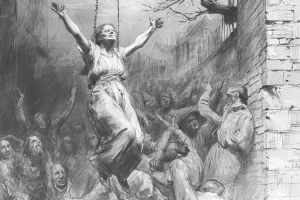The Witch of The Opera House

The French Opera House of New Orleans opened in 1859. It was home to many an opera and made New Orleans the capital of opera in the United States. Unfortunately, the opera house burned down in 1919. But the story of love, betrayal, and tragedy will never leave these hallowed grounds.
In the 1860’s, a young woman named Marguerite made quite a splash on the scene as a performer at the French Opera House, which stood on the corner of Toulouse and Bourbon. She was no great singer, but was quite beautiful, and thus made a success of herself. As she aged, however, her career dried up quickly, as she had little other than looks to fall back on. Just as her hopes for a singing career vanished, tragedy struck; her husband was killed in a carriage accident, leaving Marguerite financially ruined and alone.
She turned to an appropriately ladylike occupation by opening a bakery with the meager inheritance from her husband’s death. Not knowing much about baking, however, she sent to Paris to hire the finest pastry chef her money could buy. He arrived, and she found him a very attractive young man. The chef quickly became her lover, and she kept him in high style. Soon, though, she began to feel he was drawing away from her. One night, she decided to follow him and she discovered he had a new lover. It was a young woman closer to his age, who he was keeping in a second-floor love nest at St. Ann and Royal.
Marguerite waited beneath the apartment’s balcony, and heard the young lovers talking. The young woman begged him to marry her. He told her that he would rid himself of “that old hag” soon enough. Marguerite waited until the apartment grew quiet. She crept upstairs, tightly closed the windows, and suffocated the lovers by turning on the gas in the apartment’s fireplace. She left, but not before slipping a note of apology for what she had done, and was about to do, between the bricks of the fireplace.
While she had been cheated, she was still in love with the young chef. She tearfully dragged her way to the French Opera House, and there she hung herself from the rafters with a bit of rope. From that date, in the late 1870’s, people experienced a disturbing haunting, which they called the “Witch of the French Opera House”. A mournful spirit, dressed only in tattered cloth, she was seen dragging along the streets between the Opera House and the apartment where she had killed the young lovers. She was often heard wailing and screaming so loudly as to awaken the slumbering residents of the French Quarter.
The Opera House burned in 1919, but still this spirit is reported almost nightly, traipsing between the two locations. In the 1950’s, a workman renovating the former apartment of the lovers found her note of apology, and upon reading it, tossed it in the fireplace. The Witch of the Opera House was heard letting out one last otherworldly shriek, and was never seen or heard from again. It is believed that the destruction by fire of the two things holding her to this world – the note and the Opera House – finally freed her spirit. Curiously, though, while Marguerite herself seems to have moved on, young lovers at the corner of St. Ann and Royal still often report the smell of natural gas, though there are no gas lamps or fixtures today visible at that intersection.
The Opera House has since been replaced with forgettable bars and forgettable faces. It has lost its grandeur and romance, its passion and glory. Show tunes no longer linger in the streets and costumed performers don’t line up across the stage for their final bows. What once was a place of classic music and luxury is now a place of neon lights and lounges filled with smoke.
Sources
“French Opera House.” Wikipedia, Wikimedia Foundation, 10 May 2018, en.wikipedia.org/wiki/French_Opera_House.
Click here for more information about the French Opera House.
writer, Contributing. “Remembering the Night the French Opera House Burned.” NOLA.com, NOLA.com, 31 Mar. 2017, www.nola.com/300/2017/03/french_opera_house_new_orleans_03312017.html.
